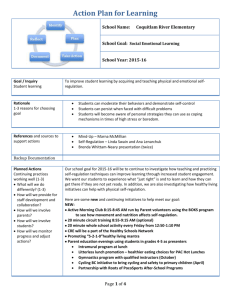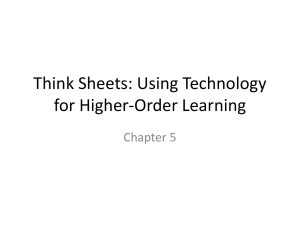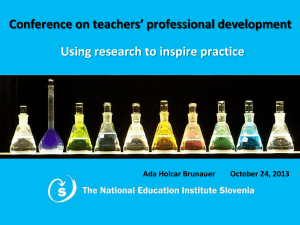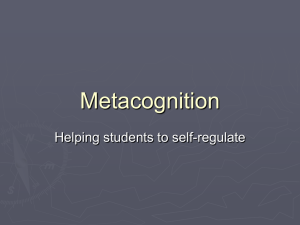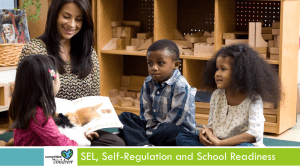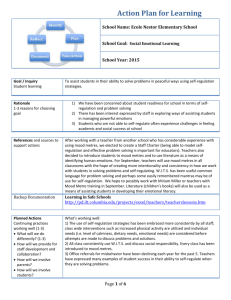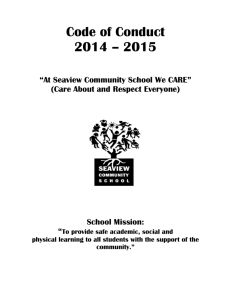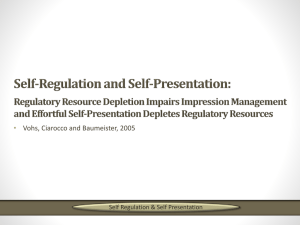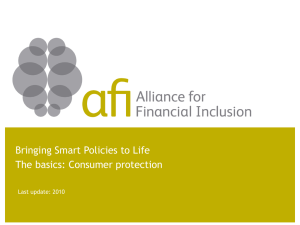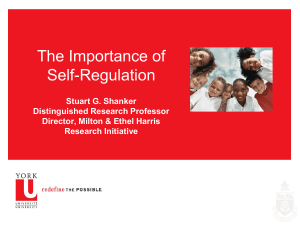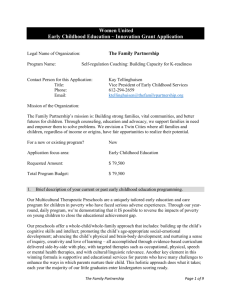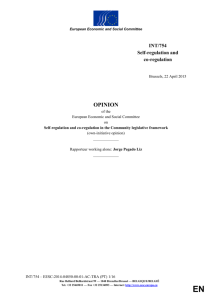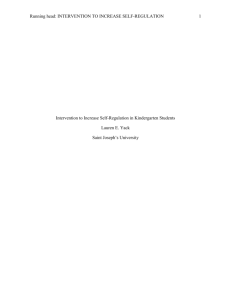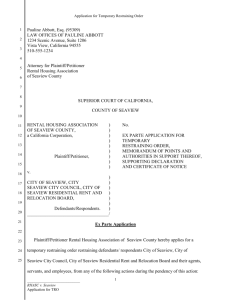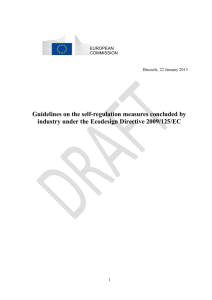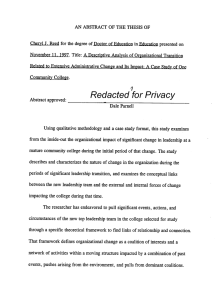Seaview APL 2015
advertisement
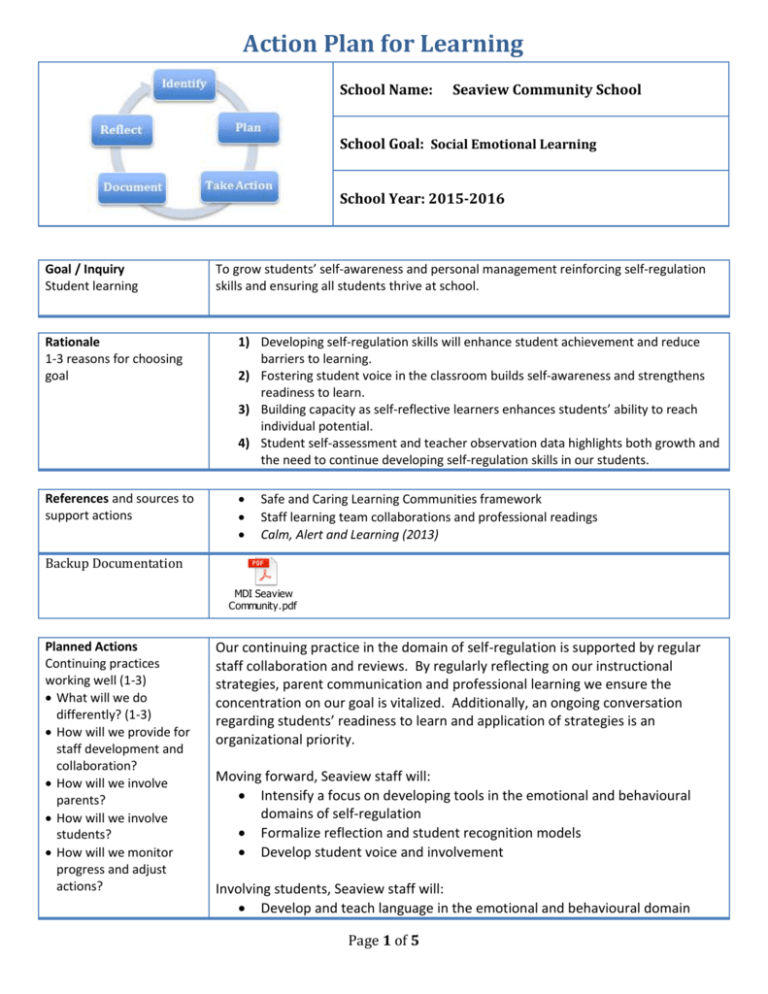
Action Plan for Learning School Name: Seaview Community School School Goal: Social Emotional Learning School Year: 2015-2016 Goal / Inquiry Student learning To grow students’ self-awareness and personal management reinforcing self-regulation skills and ensuring all students thrive at school. Rationale 1-3 reasons for choosing goal 1) Developing self-regulation skills will enhance student achievement and reduce barriers to learning. 2) Fostering student voice in the classroom builds self-awareness and strengthens readiness to learn. 3) Building capacity as self-reflective learners enhances students’ ability to reach individual potential. 4) Student self-assessment and teacher observation data highlights both growth and the need to continue developing self-regulation skills in our students. References and sources to support actions Safe and Caring Learning Communities framework Staff learning team collaborations and professional readings Calm, Alert and Learning (2013) Backup Documentation MDI Seaview Community.pdf Planned Actions Continuing practices working well (1-3) What will we do differently? (1-3) How will we provide for staff development and collaboration? How will we involve parents? How will we involve students? How will we monitor progress and adjust actions? Our continuing practice in the domain of self-regulation is supported by regular staff collaboration and reviews. By regularly reflecting on our instructional strategies, parent communication and professional learning we ensure the concentration on our goal is vitalized. Additionally, an ongoing conversation regarding students’ readiness to learn and application of strategies is an organizational priority. Moving forward, Seaview staff will: Intensify a focus on developing tools in the emotional and behavioural domains of self-regulation Formalize reflection and student recognition models Develop student voice and involvement Involving students, Seaview staff will: Develop and teach language in the emotional and behavioural domain Page 1 of 5 Encourage student problem-solving and reflection Scaffold the use of tools and language in the school environment both at work and play Involving parents, Seaview staff will: Regularly communicate in the school newsletter’s Self-Regulation Parents’ Corner Provide parent education and dialogue at school events and reporting conferences Encourage application of strategies and language used at school at home Monitoring our progress through monthly staff collaborations during our staff meeting time, four times per year Chat ‘n Chews (a small group collaborative structure involving professional readings and strategies review), teacher observations and student self-assessment will continue at Seaview. Additionally, expanding our relationships with partner elementary schools by participating in visits, exchanges and resource sharing will provide opportunities for input and the sharing of ideas to enhance our actions at Seaview. Backup Documentation Self Regulation Self-Reglation Staff Collaboration Parents' Corner sample.doc Parents' Corner - sample 2.doc sample.jpg Page 2 of 5 Student Recognition.jpg Student Recognition - parent.jpg Documentation of learning Key evidence of change How did your actions make a difference? Choose 1-3 pieces of evidence to demonstrate the impact your actions have had on student learning to meet your goal. Documentation could include video, survey results, performance standard data, anecdotal evidence, work samples, etc. Over the course of our current school year, we have observed significant growth across grades in students’ application of tools to support their sensory readiness to learn in the classroom and be calm, alert and ready in all variety of learning environments in our school: the language and practice is culturally shared. We have experienced: an increase in students’ ability to identify and use tools that work for them in the classroom an increase in students’ ability to articulate the ‘why’ and the ‘how’ behind readying themselves to learn an understanding that using tools to prepare themselves for learning is universally accepted in our school an increase in students supporting one another in the classroom and on the playground with language and behaviours that support self-regulation Teachers have collected and reflected on a wide range of data this school year ranging from anecdotal surveys and rating scales, individual and 3-way parentstudent-teacher conferences, personal writing and teacher observation. Class meeting structures are in place in every classroom and the topic of self-regulation and readiness to learn is embedded daily. Our current student recognition program is delineated along specific actions we recognize that demonstrate selfregulation skills. Daily, communication of students being recognized for selfregulatory behaviours is sent home to parents. In our monthly assembly, we recognize a large group of students for one specific action related to selfregulation. Backup Documentation Student Spring2015.grade2.3 Student Student Student Work.jpg Self-Assessment Spring 2015 K-1.doc .doc Self-Assessment Div 3Self-Assessment 4 & 5 Spring 2015.g45.doc 4 & 5 Spring 2015.g45.doc Student Work strengths.jpg Reflection Highlights Where are we now? What are some patterns emerging? What surprised you? What conclusions / inferences might you draw? How does this inform potential next steps? Student work strengths1.jpg At Seaview, we are ready to, while maintaining our momentum in the calm, alert and ready to learn domain, begin an intentional increase in our focus on teaching and learning in the emotional and behavior domains of self-regulation. We have noticed that our students “get” that the strategies they use are effective. They have developed and apply appropriate language and communication of their self-regulation needs and they can readily identify effective tools. We are surprised by our students’ readiness and depth of understanding in using selfregulation tools at school and have observed a significant impact in our parent community rendering use of the self-regulation lens very important when we are dealing together with conversations around student learning, relationships and achievement at school. With a developing dialogue in the broader public about self-regulation in the background, we find that our community is interested and curious about this work and supportive as they recognize the positive impact on their children’s learning at school. In the coming year, our intention is to maintain and continue the momentum we have Page 3 of 5 created in the development of a community focus on building self-regulation skills in our students. We can infer that the progress our students have made in the sensory domain will provide an important foundation for our increase in focus on developing tools in the emotional and behavioural domains of self-regulation in the 2015-2016 school year. Furthermore, we believe that continuing to collect data from a broad-based perspective will guide us in our expanded instructional focus moving forward. Backup Documentation Self-Regulation Tiers working model.jpg (Delete this section if Literacy is your main goal) Literacy Data Attach the following : Seaview - CBA for Classroom Assessment APL 2015.doc School Assessment FSA results Page 4 of 5 Signatures School Name: School Goal: Numeracy School Year: Submitted by School Planning Council: Title Name Principal Parent Parent Parent Recommended by Assistant Superintendent: Assistant Superintendent Board and Superintendent Approval: Board Chair Judy Shirra Superintendent Patricia Gartland Print this page, have it signed by School Planning Council, scan it and attach it here Page 5 of 5 Signature

